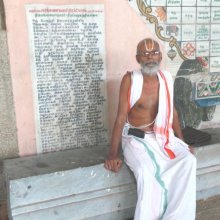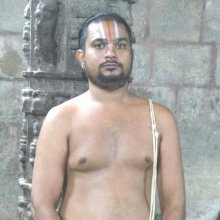Vaikuntam, Vaikuṇṭam: 6 definitions
Introduction:
Vaikuntam means something in Hinduism, Sanskrit, the history of ancient India, biology, Tamil. If you want to know the exact meaning, history, etymology or English translation of this term then check out the descriptions on this page. Add your comment or reference to a book if you want to contribute to this summary article.
Images (photo gallery)
In Hinduism
Vaishnavism (Vaishava dharma)
Source: Acta Orientalia vol. 74 (2013): Historical sequence of the Vaiṣṇava DivyadeśasVaikuntam refers to one of the 108 Vaishnava Divya Desam (divyadeśas or divyasthalas), located in the topographical division of Malaināṭu (“hill Country”), according to the 9th century Nālāyirativviyappirapantam (shortly Nālāyiram).—Tradition would record the Vaiṣṇava divyadeśas or divyasthalas are 108. The divyadeśa is a base of the cult of Viṣṇu in Viṣṇuism [Vaiṣṇavism] tradition. The list of 108 [viz., Vaikuntam] seems to have reached maturation by about the early 9th century CE as all the deśas are extolled in the hymns of the twelve Āḻvārs.
Vaikuntam (Vaikuṇṭha) or Paramapadam could also refer to one of the 108 Vaishnava Divya Desam located in the topographical division of “heaven”.
Source: academia.edu: Dvādaśa-mūrti in Tamil TraditionVaikuntam (வைகுந்தம்) refers to one of the Navatiruppati: a collection of nine Temples (divyadeśas) nearby Kurukūr (modern Āḻvārtirunakari): the birth-place of Nammāḻvār.—[...] Nammāḻvār was born in Kurukūr (modern Āḻvārtirunakari), a majestic temple of the Nāyaka period is today found in this city-like-village. Nearby nine Divyadeśas are located that are collectively known as Navatiruppati [e.g., Vaikuntam].

Vaishnava (वैष्णव, vaiṣṇava) or vaishnavism (vaiṣṇavism) represents a tradition of Hinduism worshipping Vishnu as the supreme Lord. Similar to the Shaktism and Shaivism traditions, Vaishnavism also developed as an individual movement, famous for its exposition of the dashavatara (‘ten avatars of Vishnu’).
Purana and Itihasa (epic history)
Source: Shodhganga: Temples and cult of Sri Rama in TamilnaduVaikuntam refers to one of the 108 divyadesas according to Priyavaccan Pillai’s compendium of the Ramayana based on the Nalayirativviyappirapantam.—Vaikuntam is the venue where the Lord Vaikunthamurti appears with Adisesa, holding the umbrella. The Lord is called Kallarpiran by the folk.

The Purana (पुराण, purāṇas) refers to Sanskrit literature preserving ancient India’s vast cultural history, including historical legends, religious ceremonies, various arts and sciences. The eighteen mahapuranas total over 400,000 shlokas (metrical couplets) and date to at least several centuries BCE.
India history and geography
Source: Institut Français de Pondichéry: The Shaivite legends of KanchipuramVaikuṇṭam (வைகுண்டம்) (in Tamil) refers to Vaikuṇṭha in Sanskrit, and represents one of the proper nouns mentioned in the Kanchipuranam, which narrates the Shaivite Legends of Kanchipuram—an ancient and sacred district in Tamil Nadu (India). The Kanchipuranam (mentioning Vaikuṇṭam) reminds us that Kanchipuram represents an important seat of Hinduism where Vaishnavism and Shaivism have co-existed since ancient times.

The history of India traces the identification of countries, villages, towns and other regions of India, as well as mythology, zoology, royal dynasties, rulers, tribes, local festivities and traditions and regional languages. Ancient India enjoyed religious freedom and encourages the path of Dharma, a concept common to Buddhism, Hinduism, and Jainism.
Biology (plants and animals)
Source: Google Books: CRC World Dictionary (Regional names)Vaikuntam in India is the name of a plant defined with Leucas aspera in various botanical sources. This page contains potential references in Ayurveda, modern medicine, and other folk traditions or local practices It has the synonym Phlomis pluckenetii Roth (among others).
Example references for further research on medicinal uses or toxicity (see latin names for full list):
· Systema Vegetabilium (1825)
· Rev. Hortus Malab. (1839)
· Flora of the British India (1885)
· Enum. Hort. Berol. Alt. (1822)
· Enum. Pl. (1809)
If you are looking for specific details regarding Vaikuntam, for example chemical composition, extract dosage, pregnancy safety, diet and recipes, health benefits, side effects, have a look at these references.

This sections includes definitions from the five kingdoms of living things: Animals, Plants, Fungi, Protists and Monera. It will include both the official binomial nomenclature (scientific names usually in Latin) as well as regional spellings and variants.
Languages of India and abroad
Tamil dictionary
Source: DDSA: University of Madras: Tamil LexiconVaikuṇṭam (வைகுண்டம்) noun < vaikuṇṭha.
1. Viṣṇu’s heaven; திருமாலுலகம். [thirumalulagam.] (பரிபாடல் [paripadal] 13, 13, உரை. [urai.])
2. White dead nettle. See தும்பை¹ [thumbai¹], 1, 2,
3. (வைத்திய மலையகராதி [vaithiya malaiyagarathi])
--- OR ---
Vaikuntam (வைகுந்தம்) noun See வைகுண்டம். வைகுந்தங் காண்பார் விரைந்து [vaigundam. vaigunthang kanpar virainthu] (நாலாயிர திவ்யப்பிரபந்தம் இயற். நான்முகன் திருவங்தாதி [nalayira thivyappirapandam iyar. nanmugan thiruvangthathi] 79).
Tamil is an ancient language of India from the Dravidian family spoken by roughly 250 million people mainly in southern India and Sri Lanka.
See also (Relevant definitions)
Query error!
Full-text: Pulokavaikuntam, Makavintam, Jayavijayar, Vaikuntha, Vinnakar, Vittunupatam, Vaikuntaccalla, Tirunatu, Shrivaikuntha, Kalanka-perunakaram, Cuttacattuvam, Tirunatalankari, Cayavicayar, Vaikuntavekataci, Navatiruppati, Vaikuntanatan, Paramapadam, Pandinatu, Tali.
Relevant text
Search found 13 books and stories containing Vaikuntam, Vaikuṇṭam, Vaikundam, Vaigundam, Vaikuntham, Vaiguntham; (plurals include: Vaikuntams, Vaikuṇṭams, Vaikundams, Vaigundams, Vaikunthams, Vaigunthams). You can also click to the full overview containing English textual excerpts. Below are direct links for the most relevant articles:
Tiruvaymoli (Thiruvaimozhi): English translation (by S. Satyamurthi Ayyangar)
Pasuram 4.8.11 < [Section 8 - Eighth Tiruvaymoli (Eru alum Iraiyonum)]
Pasuram 4.4.1 < [Section 4 - Fourth Tiruvaymoli (Mannai iruntu tulavi)]
Pasuram 9.2.4 < [Section 2 - Second Tiruvaymoli (Pantai nalale)]
Sri vaishava divya desams < [Volume 11 (issue 3-4), Jan-Jun 1992]
Garga Samhita (English) (by Danavir Goswami)
Verse 4.22.10 < [Chapter 22 - Nanda and the Gopas See the Realm of Vaikuntha]
Sucindrasthala-mahatmya (critical edition and study) (by Anand Dilip Raj)
Chapter 22 - Dvavimsha Adhyaya (dvavimso'dhyayah) < [Chapter 5 - Sucindrasthalamahatmya: Sanskrit critical edition]
Chapter 12 - Dvadasha Adhyaya (dvadaso'dhyayah) < [Chapter 5 - Sucindrasthalamahatmya: Sanskrit critical edition]
Antiquity of the divyakṣetras in Pāṇḍināḍu < [Volume 73 (2012)]
Historical sequence of the Vaiṣṇava Divyadeśas. Sacred venues of Viṣṇuism < [Volume 74 (2013)]
Daśāvatāras in Tamil bhakti and Vijayanagara Nāyaka sculptures. < [Volume 73 (2012)]
Early Chola Temples (by S. R. Balasubrahmanyam)
Temples in Tirunaraiyur < [Chapter VIII - Temples of Uttama Chola’s Time]

